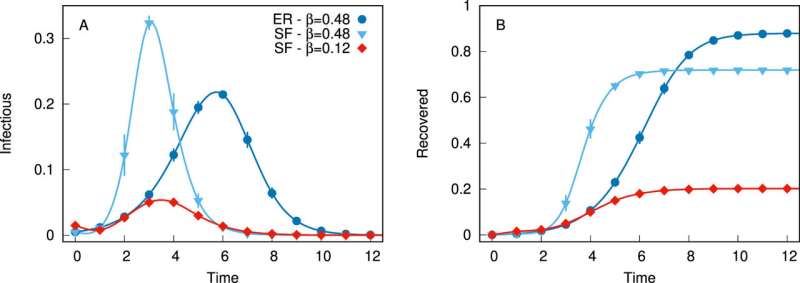This article has been reviewed according to Science X's editorial process and policies. Editors have highlighted the following attributes while ensuring the content's credibility:
fact-checked
trusted source
proofread
Overhaul epidemic modeling to include social networks, says new research

Models used by scientists to predict how epidemics will spread have a major flaw since they do not take into account the structure of the networks underlying transmission.
According to a new study from the University of Birmingham, modeling used to forecast the effects of diseases, such as COVID-19, can significantly overestimate the number of infections that will occur in an epidemic "wave."
The research, published in the Journal of Physics: Complexity¸ comes as the COVID inquiry continues to investigate what went wrong with the Government's handling of the pandemic, and what should be done better in the future.
Currently, epidemic modeling does not usually factor in that people are connected by a network of contacts where transmission might occur. Instead, many of these models, such as the ones that were used to inform decisions concerning COVID-19, make the assumption of "random mixing."
Dr. Samuel Johnson, Associate Professor in Applied Mathematics at the University of Birmingham, who conducted the study, said, "It has been known for a long time that the properties of social networks are important for epidemic spreading; we can see this in action when those who were exposed to COVID-19 through mixing with infected individuals were contacted to let them know of their exposure."
"But because we do not have a way of knowing the whole network of millions of people, modelers usually do the best they can and assume random mixing, i.e., that anyone could infect anyone else. The problem is that the properties of this network can completely change the outcomes predicted."
The research considers that if these networks are heterogeneous, meaning that some people have a lot more contacts than others, then epidemic "waves" may be much smaller than predicted by standard models. Dr. Johnson continues: "This is partly because fewer people get infected for a given transmissibility. But also, if you look at data on infections through a random-mixing lens you will overestimate transmissibility, and these two errors compound each other."
In the paper, a simple version of these models shows two epidemic waves looking initially the same, but in the random-mixing case nearly 90% of people eventually become infected, whereas on a "scale free" (heterogeneous) network it is only 20%.
Dr. Johnson also explores how changes in networks over time can lead to multiple waves of an epidemic, even after "herd immunity" has apparently been reached with previous waves. These findings might explain some of the big mistakes that groups modeling the pandemic seem to have made.
"Not everyone has the same numbers of friends, family, and colleagues or goes out to places where large groups of people may be present," explained Dr. Johnson. "And the fact that superspreader events play such a significant role in the early stages of an epidemic supports the hypothesis that the real network of contacts is, like many other social networks, highly heterogeneous."
The study argues that the structure of social networks cannot be ignored if epidemic modeling is to make useful predictions.
Dr. Johnson concluded, "Taking social networks into account should be a fundamental part of epidemic modeling. Even if we do not know what the network is like in detail, it still might be better to factor in that it is probably heterogeneous. And it is certainly preferable to realize we have this uncertainty rather than assuming that, because we have put lots of other ingredients into our models, they will make useful crystal balls."
"As the political psychodrama of the COVID Inquiry continues to be played out in the news, it is important to note that the government, scientists, and wider society should be learning from what went wrong during the pandemic and what went well. For example, rather than focusing on who said what in the UK, we could compare what happened in other countries when different measures were implemented."
"We need to make improvements so that we are ready for the next one, and working out how to account for social networks in epidemic modeling would be a big first step."
More information: Samuel Johnson, Epidemic modelling requires knowledge of the social network, Journal of Physics: Complexity (2024). DOI: 10.1088/2632-072X/ad19e0





















